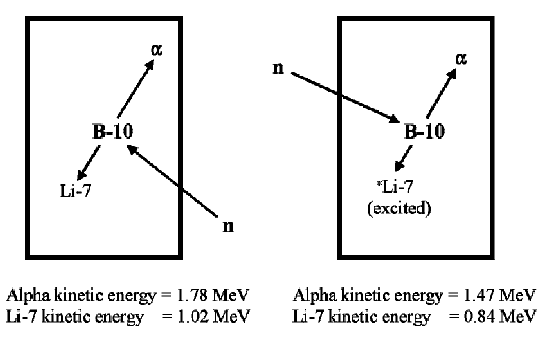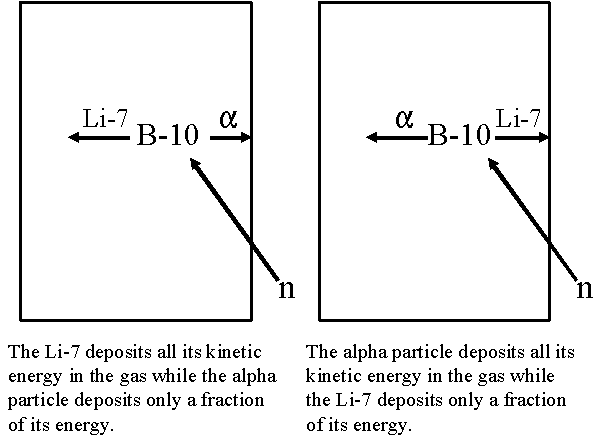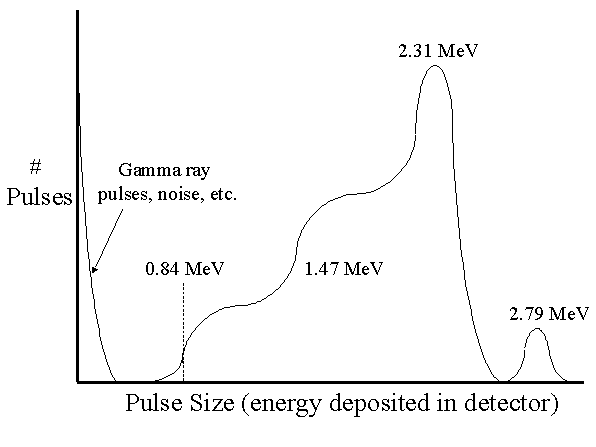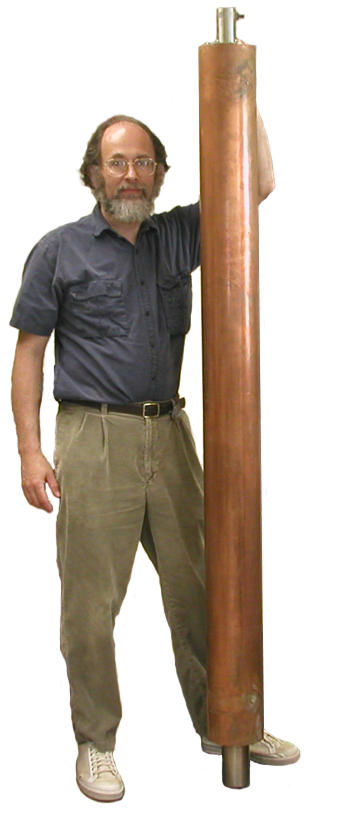Neutron Detectors
Boron Trifluoride (BF3) Neutron Detectors
Paul Frame, Oak Ridge Associated Universities
General
A typical BF3 detector consists of a cylindrical aluminum (brass or copper) tube filled with a BF3 fill gas at a pressure of 0.5 to 1.0 atmospheres. The boron trifluoride gas accomplishes two things:
C it functions as the proportional fill gas.
C it undergoes an n alpha interaction with thermal neutrons: B-10 + n ÿ Li-7 + α
To improve the detection efficiency, the BF3 is enriched in B-10. Typical enrichments increase the B-10 component to 96% (ordinary boron is 20% B-10 and 80% B-11). Aluminum is typically used as the detector (cathode) wall because of its small cross section for neutrons. The anode is almost always a single thin wire running down the axis of the tube.
Pulse formation by neutrons
When a neutron is absorbed by the B-10 component of the gas, an alpha particle and a recoil Li-7 nucleus are produced that travel off in opposite directions. The movement of the alpha particle and Li-7 nucleus create primary ion pairs in the gas.
The size of the resulting pulse depends on whether the lithium nucleus was left in the ground state or an excited state. When the lithium nucleus is left in the ground state (about 6% of the time), the pulse is larger than if the nucleus were left in an excited state (about 94% of the time) because the alpha particle and Li-7 nucleus have more kinetic energy (2.792 MeV vs 2.310 MeV) with which to create ion pairs.

The BF3 spectrum and the wall effect
In a large diameter detector, all the kinetic energy of the alpha particle and recoil Li-7 nucleus is deposited in the detector gas. The pulse height spectrum therefore shows two peaks: a large one at 2.31 MeV (the lithium nuclei were left in an excited state) and a small one at 2.792 MeV (the lithium nuclei were left in the ground state).
For typical sized tubes (e.g., 2-5 cm diameter), smaller pulses are often produced because either the alpha particle or Li-7 nucleus deposit some of its energy in the detector wall rather than the gas. Only rarely would the alpha particle and Li-7 nucleus both strike the detector wall. If the neutron interaction takes place in the gas close enough to one side of the tube for either the alpha particle or lithium nucleus to strike the wall, the distance to the other side of the tube would be greater than the range of the particle heading towards it.

The resulting "wall effect" creates two steps on the left side of the 2.31 MeV peak. The lower step on the left is produced as a result of the alpha particle striking the wall and the Li-7 depositing all its energy (e.g., 0.84 MeV) in the gas. The higher step to the right results from the Li-7 nucleus striking the wall and the alpha particle depositing all its energy (e.g., 1.47 MeV) in the gas.
The following is a "textbook" version of the pulse height spectrum of a BF3 detector. A "real" spectrum is not quite as well defined. In particular, the two steps to the left of the 2.31 MeV peak are more difficult to distinguish than shown here.

It is important to remember that this spectrum is unrelated to neutron energy—it is simply a function of the detector construction. In almost all cases, it is the count rate from the detector that carries useful information, not the pulse height.
Note that gamma rays produce relatively small pulses and these can be easily rejected by properly setting the threshold. Increasing the size of the detector reduces the wall effect seen in the above spectrum and this makes it easier to distinguish gamma pulses from those produced by neutrons.
Operating voltage and the characteristic curve
The best way to determine the operating voltage of a BF3 detector is to generate a characteristic curve (count rate versus high voltage). The curve is similar to that of a Geiger-Mueller detector in that they both have long flat plateaus. As was the case with the GM detector, the operating voltage of the BF3 detector should be selected on the plateau just above the knee. If the operating voltage is set too high, electronic noise and pulses due to background gamma rays can exceed the threshold setting and generate spurious counts. A typical voltage for a BF3 detector might be 1500 to 2000 volts.
Detection of thermal and fast neutrons
"Bare" BF3 detectors almost exclusively respond to slow (low energy) neutrons—the probability that a fast (high energy) neutron would be absorbed by boron-10 is very small. To be able to detect fast neutrons, the BF3 tube can be surrounded by a suitable moderator. The thickness of the moderator (e.g., polyethylene) might range from 1 to 6 inches depending on the neutron energy spectrum and other constraints.
-
20th Century Electronics Proportional Counter 20th Century Electronics Proportional Counter

-
20th Century Electronics Proportional Counter 20th Century Electronics Proportional Counter

-
Chalk River BF3 Proportional Counter Chalk River BF3 Proportional Counter

-
Large Chalk River BF3 Proportional Counter Large Chalk River BF3 Proportional Counter

-
Nancy Wood BF3 Proportional Counter Nancy Wood BF3 Proportional Counter

-
Nuclear-Chicago Model NC-205 BF3 Counter Nuclear-Chicago Model NC-205 BF3 Counter

-
RCL Mark 2, Model 1 Proportional Counter RCL Mark 2, Model 1 Proportional Counter

-
RCL Mark 2, Model 201 Proportional Counter RCL Mark 2, Model 201 Proportional Counter

